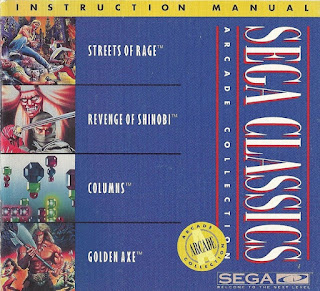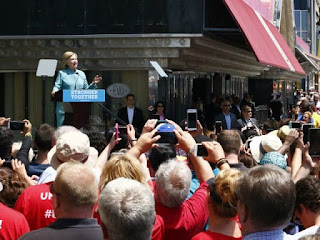Developer- Sega
Platform- Sega CD
Released- 1992, 1994
Platform- Sega CD
Released- 1992, 1994
By late 1992 the Sega Genesis had already been out for three years, and the 16-bit landscape was changing dramatically. Developers had gotten comfortable with the hardware and were able to pump out games with graphics and sound like never before. Earlier releases were almost quaint by comparison but certainly impressive in their time, matching their arcade counterparts almost one-to-one. But just because their presentation was more modest didn’t mean their gameplay was no less compelling, and Sega saw an opportunity to bolster their game library with re-issues of these launch-era games at a budget price under the new label ‘Sega Classic.’ Of course today this sales strategy is nothing new, but it’s easy to forget that in the pre-Internet era, physical games only had a set print run and after a certain time could no longer be found in stores. Anyone who wanted to revisit the Genesis’ earlier releases would have to trade with friends or rely on the dumb luck that a particular store happened not to sell out of their inventory that wasn’t recalled by the vendor to make space for newer titles. Under this new label, these older games would once again find their place on the shelf for fans old and new, repackaged as if to be collected, and Sega would claim more revenue and consumer attention for virtually no effort.
Also by late 1992, the Sega CD was released with high promise and a higher price tag. In order to ease the sticker shock, Sega bundled the add-on with three pieces of software which showed off three of the several areas in which the CD technology would enhance the Sega home experience: video, soundtrack, and storage. For video, Sega included Sherlock Holmes, a series of point-and-click mysteries with copious amounts of video playback. For soundtrack, Sega included Sol-Feace, a sidescrolling space shooter that had previously seen a release on the Genesis as Sol-Deace. Though the game was the same, this edition boasted a completely new, CD-quality soundtrack that was a major step up from the cartridge chiptunes and therefore worth revisiting.

The game's menu, with five games? More on that later.
The Sega Classics Arcade Collection was the third included disc in the Sega CD’s launch package, and used the storage capability of the disc to include four full games that were part of the aforementioned re-release series. The games chosen were Golden Axe (beat-em-up), The Revenge of Shinobi (action platformer), Streets of Rage (beat-em-up), and Columns (puzzle). Each game is a strong entry and worthy of being called a Sega Classic, even if only Golden Axe and Columns are actually arcade conversions. Revenge of Shinobi is a sequel in the arcade-based Shinobi series, and Streets of Rage harkens to the arcade mentality that dominated the Genesis’ early life, so perhaps that allows them to pass under the ‘arcade’ moniker.

As a CD title, the collection begins with an animated Sega logo—these creative and unique animations are a staple of the Genesis era, but here was the first time it was seen in computer-generated 3D on a video clip. This boots to a simple but efficient game menu, with animated highlights and CD-quality music that sounds downright royal. As for the games themselves, they play exactly as their cartridge counterparts and sound the same… or do they?
Golden Axe- The entire soundtrack has been replaced with that of the original arcade version. This is an odd enhancement, as technically it is CD-quality but the arcade still used synthesized music. The voices have also been re-recorded to CD-quality which is a noticeable and welcome change. The sound effects unfortunately remain loud and bloopy, and threaten to nullify all of the other audio enhancements. Also inexplicably, the game is now 1-player only.
The Revenge of Shinobi- This is 100% the same as the cartridge version.
Streets of Rage- The voices have been re-recorded to CD-quality.
Columns- A brand-new, CD-quality theme has been added to the title screen, which in the original Genesis version had been mute. A hollow gesture, as it is abruptly ended at the press of the start button. Start the game quickly and it cannot be heard at all.
Highlighting these music differences brings up the most disappointing aspect of this collection: Sega proved they could enhance the music of the different games to CD-quality and effectively didn’t. All four games have very strong soundtracks on their own, yes, but who wouldn’t want to hear live renditions of Columns’ distinct themes, or Streets of Rage’s techno masterpieces in full fidelity?
The Sega Classics Arcade Collection was designed to show off the storage capacity of the Sega CD, able to hold multiple cartridge games on one disc, but was also a low-effort way to instill value in the launch package. Even without enhancements, players were still getting four games for free that were otherwise being sold separately for a total value of roughly $80-$100. The point of the collection was not to show-off or draw any additional development away from other projects. Sega really didn’t need to make a particularly strong effort; the draw of the disc was cost savings it represented, and it was never made available for individual sale. Remastering Golden Axe’s music (with the already-made arcade version) was likely a proof-of-concept for Sega, as they were still getting used to their new media development.
This collection could have easily become a springboard for a series of Sega Classic compilation discs, which could have received more budget and development time for remastered audio. Many new-release Genesis titles indeed received this treatment, but the older Sega Classic games remained overlooked.
As the Sega CD grew its own library and reputation, and the Model 2 version released with a price drop, the Arcade Collection value crutch was no longer needed and was phased out of the hardware bundles. But in 1994, a new challenger approached: the Genesis CDX. This was a radical, all-new redesign that packed a Genesis and Sega CD into a single compact unit. Its price was steep, costing more than the two consoles combined and selling mostly on its looks and perceived coolness. Once again, a no-effort value proposition was needed, and so the Sega Classics Arcade Collection was revived as one of the several pack-in titles for the CDX. But this time, either for additional value or out of Sega’s sheer boredom, a fifth game was added to the collection. Super Monaco GP joined the ranks of its classic cousins with no enhancements, though at least it earns its relevancy as a true former arcade title.
By 1995 the Sega CD had been phasing out, and the Sega Classics line along with it, ultimately being replaced by a Mega Value line of more recent titles with a similar budget price. But some of the Sega Classic games still made one final appearance on store shelves! In later Genesis hardware bundles, and also as a standalone release, Sega released the 6-Pak, a compilation of six Sega Classic games on one cartridge. The box art’s theming was replaced to match Sega’s newer, edgier asthetic, but make no mistake these were the same slew of workhorse games that had done Sega well in their quest to promote high-quality gameplay and value-for-money despite their lack of technical prowess. It’s interesting how over time such a large compilation cart may not have been financially viable, instead relying on CDs for that kind of storage, such a compilation was eventually doable, and they were able to squeeze in a sixth game at that! Super Monaco GP was swapped out for Super Hang-On and subsequently re-re-released in the Mega Value line, and Sonic the Hedgehog was added as the sixth game.
 |
| Note the same 'Classics' font was used in the header. |





















